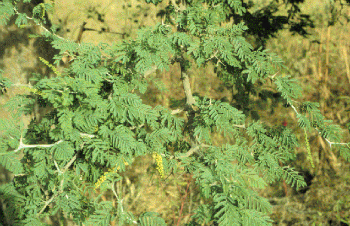Scientists have discovered that an acacia tree, long used by farmers in parts of Africa, could dramatically raise food yields in Africa. The acacia tree Faidherbia albida, also known as Mgunga in Swahili, possesses the unique ability to provide much-needed nitrogen to soil.
The tree becomes dormant in early rainy season, shedding its nitrogen-rich leaves onto the ground, just in time for farmers’ seeds to soak up their nitrogen. Also, since the tree loses its leaves at the time when farmers are planting—and grows them back after harvest in the dry season—it also does not compete with crops for sunlight.
“Knowledge of this tree is farmer-driven,” Dennis Garrity, Director General of the World Agroforestry Centre, or ICRAF, one of 15 centers supported by the Consultative Group on International Agricultural Research (CGIAR). “We are now combining the scientific knowledge base with the farmer knowledge base. There is sufficient research on both sides to warrant dramatically scaling-up the planting of this tree on farms across Africa through extension programs. The risks to farmers are low; it requires very little labor, and delivers many benefits.”
Unlike most regions in the world, agricultural yields in Africa have not been increasing. yet the number of people requiring food in Africa continues to grow, leading to an on-going food crisis in many parts of the continent.
 Branches and leaves of the Mgunga tree. |
One of the reasons for low yields has been a lack of nitrogen in the soil. Sub-Saharan Africa uses significantly less fertilizer than other regions, applying only 10 percent on average of what the rest of the world applies and 2 percent of what China applies. Fertilizer is too expensive for many farmers in Africa, and with fertilizer prices on the rise, purchasing fertilizer has become even more daunting for the average African farmer.
Some scientists see increasing synthetic fertilizers in Africa as the key to increasing years—with suggestions like subsidizing fertilizer—others worry that synthetic fertilizer could in the long run further degrade already sensitive land. The Mgunga tree may be a more cost-effective and environmentally friendly way of increasing stalled yields.
Scientists began researching the tree over 60 years after noticing farmers leaving it stand in sorghum and millet fields. A study in Malawi found that maize yields jumped 280 percent when the crop was planted under the Mgunga tree canopy rather than outside it. Unpublished research in Zambia found an increase from an average 1.3 tons of maize per hectare outside of the trees’ range to 4.1 tons of maize per hectare when planted near the tree. None of the maize had been fertilized.
Some nations have started to react to these findings. The Departments of Agriculture in both Zambia and Malawi are hoping to double maize production by requesting farmers to plant one hundred Mgunga trees on every hectare of maize crops.
The research on the Mgunga was presented made at the 2nd World Congress of Agroforestry in Nairobi, Kenya hosted by ICRAF.
“Growing the right tree in the right place on farms in sub-Saharan Africa—and worldwide— has the potential to slow climate change, feed more people, and protect the environment,” Garrity added. “This tree, as a source of free, organic nitrogen, is an example of that. There are many other examples of solutions to African farming that exist here already.”
Related articles
Monsanto GM Corn a Disaster in South Africa
(07/31/2009) Three different varieties of genetically modified (GM) corn provided by the Monsanto Corporation to farmers in South Africa have been reported to be failing to seed. The company claims that “less than 25 percent” of the seeds were susceptible to the problem, and that the crop failure was caused by “underfertilization processes in the laboratory.”
What is the crop productivity and environmental impact of too much or too little fertilizer?

(06/18/2009) While the use of synthetic fertilizer has greatly increased agricultural production globally—helping to feed a global population that is not slowing down—it has brought with it high environmental costs. Fertilizer runoff has polluted many coastal regions creating ‘dead zones’ where the ocean is starved of oxygen by the influx of nitrogen. Synthetic fertilizers have also polluted the air with ammonia, and sent emissions of nitrous oxide into the atmosphere, contributing to global warming.
Congo biochar initiative will reduce poverty, protect forests, slow climate change

(05/19/2009) An initiative using soil carbon enrichment techniques to boost agricultural yields, alleviate poverty, and protect endangered forests in Central Africa was today selected as one of six projects to win funding under the Congo Basin Forest Fund (CBFF). The scientific committee of the CBFF awarded Belgium’s Biochar Fund and its Congolese partner ADAPEL €300,000 to implement its biochar concept in 10 villages in the Equateur Province of the Democratic Republic of Congo. The approach improves the fertility of soils through the introduction of “biochar” — charcoal produced from the burning of agricultural residues and waste biomass under reduced oxygen conditions — thereby increasing crop yields and reducing the need to clear forest for slash-and-burn agriculture.







